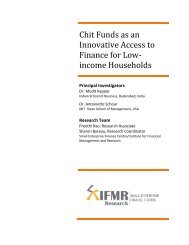Government of India Volume I: Analysis and Recommendations
Government of India Volume I: Analysis and Recommendations
Government of India Volume I: Analysis and Recommendations
Create successful ePaper yourself
Turn your PDF publications into a flip-book with our unique Google optimized e-Paper software.
Table <strong>of</strong> <strong>Recommendations</strong> 4.17 Judicial structure <strong>of</strong> tribunal<br />
FUNCTIONS AND POWERS OF THE REGULATOR<br />
For creating a clear judicial structure for the appellate tribunal, the Commission recommends the following provisions:<br />
1. The appellate tribunal will be headed by a presiding <strong>of</strong>ficer who is qualified to be a Judge <strong>of</strong> Supreme Court,<br />
Chief Justice <strong>of</strong> a High Court, or has served for at least seven years as a Judge <strong>of</strong> a High Court;<br />
2. The tribunal will have at least two members; the specific number <strong>of</strong> members <strong>of</strong> a tribunal will be determined<br />
by the case load;<br />
3. The members <strong>of</strong> the tribunal must have experience in the fields <strong>of</strong> finance, economics, accountancy <strong>and</strong> law;<br />
4. The members may be formed into benches, in which case, each bench must have a person who is qualified<br />
in law; <strong>and</strong><br />
5. There will be a statutory appeal available against the decisions <strong>of</strong> the appellate tribunal to the Supreme<br />
Court.<br />
Table <strong>of</strong> <strong>Recommendations</strong> 4.18 Rules <strong>of</strong> procedure for appellate tribunal<br />
The appellate tribunal should devote attention to st<strong>and</strong>ardising the systems for:<br />
1. Application <strong>of</strong> complaints <strong>and</strong> responses;<br />
2. Implementation <strong>of</strong> temporary orders;<br />
3. Introduction <strong>of</strong> evidence;<br />
4. Hearing <strong>of</strong> arguments;<br />
5. Determination <strong>of</strong> the case; <strong>and</strong><br />
6. Determination <strong>of</strong> the penalty.<br />
skills who will be responsible for all the infrastructure <strong>and</strong> administrative functions <strong>of</strong> the<br />
appellate tribunal. To ensure that the separate registry does not undermine the independence<br />
<strong>of</strong> the tribunal, the registrar should be under the supervision <strong>of</strong> the chief judicial<br />
<strong>of</strong>ficer <strong>of</strong> the appellate tribunal.<br />
The Commission recommends the following provisions relating to the registry <strong>of</strong> the<br />
appellate tribunal to ensure its efficient functioning:<br />
1. Developing details <strong>of</strong> procedure: The draft Code requires the appellate tribunal to formulate its<br />
own regulations on procedure, <strong>and</strong> publish them so as to induce clarity amongst financial firms.<br />
These regulations, on the areas mentioned in Table 4.18, should be formed by the appellate tribunal<br />
itself.<br />
2. Using information technology: The processes <strong>of</strong> the appellate tribunal should be geared towards<br />
using information technology to integrate its entire judicial functions into an electronic form.<br />
The objective <strong>of</strong> the use <strong>of</strong> technology would be to reduce the cost <strong>of</strong> approaching the tribunal,<br />
greater efficiency in the functioning <strong>of</strong> the tribunal <strong>and</strong> greater transparency in the performance<br />
<strong>of</strong> the tribunal. Information technology should be used to reduce requirements for physical<br />
travel, keeping paper records, <strong>and</strong> following up on compliance with orders.<br />
3. Resources <strong>and</strong> reporting: The efficiency <strong>of</strong> the tribunal’s procedures need to be continuously<br />
monitored <strong>and</strong> measured. The draft Code will help achieve this by specifying that the tribunal<br />
must comply with accountability requirements through the production <strong>of</strong> detailed performance<br />
statistics, annual reports <strong>and</strong> audit reports similar to that <strong>of</strong> regulators.<br />
4.4. Conclusion<br />
The functioning <strong>of</strong> regulatory agencies is a critical component <strong>of</strong> financial law. Regulatory<br />
agencies are remarkable in featuring a combination <strong>of</strong> regulation-making power that is<br />
delegated by Parliament, executive functions, <strong>and</strong> quasi-judicial functions. In addition,<br />
there are sound reasons for favouring significant political <strong>and</strong> operational independence<br />
in regulatory agencies. In order to obtain sound outcomes, the Commission has applied<br />
meticulous care in clearly establishing unconflicted objectives, processes governing legislative<br />
<strong>and</strong> executive functions, bringing in an element <strong>of</strong> separation <strong>of</strong> powers for per-<br />
40 FINANCIAL SECTOR LEGISLATIVE REFORMS COMMISSION



